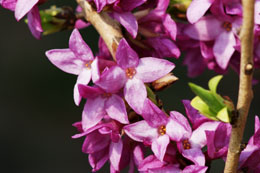Daphne is actually a genus of shrubs that are deciduous, and evergreen too. A native of Asia, Europe, and north Africa, this Buzzle article tells you more about this plant.

Although this genus is known for its flowers, they do not have petals. Instead, they have petaloid sepals, whose color may range from greenish-yellow to white, and bright pink. As observed by hobbyists, the evergreen shrubs have greenish flowers, while pink flowers are the characteristic features of the deciduous variety. Some common Daphne plant varieties include Winter Daphne (
Daphne odora), Rock Daphne (
Daphne cneorum), Flax-Leaved Daphne (
Daphne gnidium), Daphne-laurel (
Daphne laureola) and Daphne somerset (
Daphne burkwoodii).
Caring Instructions
It should be known that growing a Daphne does not come easy. It requires some effort to survive the environmental conditions, so that it can add color and vibrancy to your landscape. The instructions are as follows:
- Full sunlight throughout the day is required by the plant. So ensure that you choose a sunny location.
- Soil must be fertile, moist, and well-drained.
- If you are thinking of planting more than one, then maintain a space of at least 2 - 3 feet between them.
- Help your plant beat the summer heat by providing it with an organic mulch (3-inch layer). Mulching around it also prevents the invasion of weeds. Also, ensure that there is some space between the crown of the plant and the mulch. This would encourage air circulation and prevent fungal growth.
- During summer, water once a week; whereas during spring and fall, once every two weeks is good enough.
- If you do not feed the plant with fertilizer post blooming, it won't be able to recover its lost nutrients. So use a 10-10-10 NPK fertilizer as soon as the blooming season ends. It is recommended to water it before and after fertilization in order to prevent root burn.
- If you prune it after its blooming period, it would not only add to the health of the plant, but also enhance its beauty and looks.
- Always get rid of diseased branches, flowers, and parts that are excessively long. Flowers that have wilted or spent, must be done away with. This will help the plant in better flowering.
Planting Instructions
- After having chosen the spot, the type of soil, dig a hole that is about three times the size of the plant's root ball.
- Now, mix the soil with an organic humus, and water the hole well.
- Now place the plant in the hole (loosen the soil around the roots first). Ensure that the root ball is placed at a surface that is little higher than the ground level. In order for it to achieve the right height, you can fill the hole with more dirt.
- Refill the hole with the soil mixed with the humus. Do not forget to tap the soil gently around the root ball. This will eliminate any air pockets.
- Post planting, the plant would require about one to two gallons of water. If watering exposes the roots, then add more soil around the base.
- And, as already mentioned before, spread 3 inch of mulch around the base.
To repeat what I have mentioned, this particular variety may be little more demanding than other flowering plants, but the effort that you put in, would surely be worth the beauty the plant would add to your landscape.






 Although this genus is known for its flowers, they do not have petals. Instead, they have petaloid sepals, whose color may range from greenish-yellow to white, and bright pink. As observed by hobbyists, the evergreen shrubs have greenish flowers, while pink flowers are the characteristic features of the deciduous variety. Some common Daphne plant varieties include Winter Daphne (Daphne odora), Rock Daphne (Daphne cneorum), Flax-Leaved Daphne (Daphne gnidium), Daphne-laurel (Daphne laureola) and Daphne somerset (Daphne burkwoodii).
Although this genus is known for its flowers, they do not have petals. Instead, they have petaloid sepals, whose color may range from greenish-yellow to white, and bright pink. As observed by hobbyists, the evergreen shrubs have greenish flowers, while pink flowers are the characteristic features of the deciduous variety. Some common Daphne plant varieties include Winter Daphne (Daphne odora), Rock Daphne (Daphne cneorum), Flax-Leaved Daphne (Daphne gnidium), Daphne-laurel (Daphne laureola) and Daphne somerset (Daphne burkwoodii).